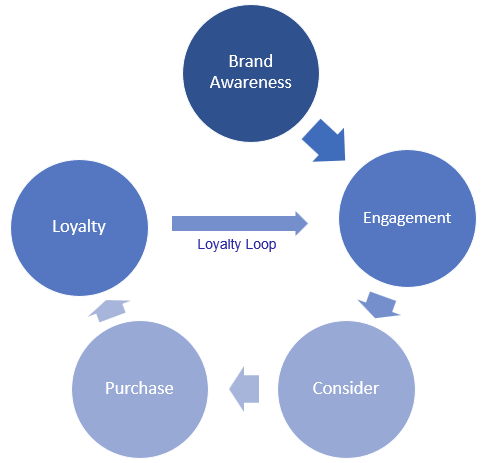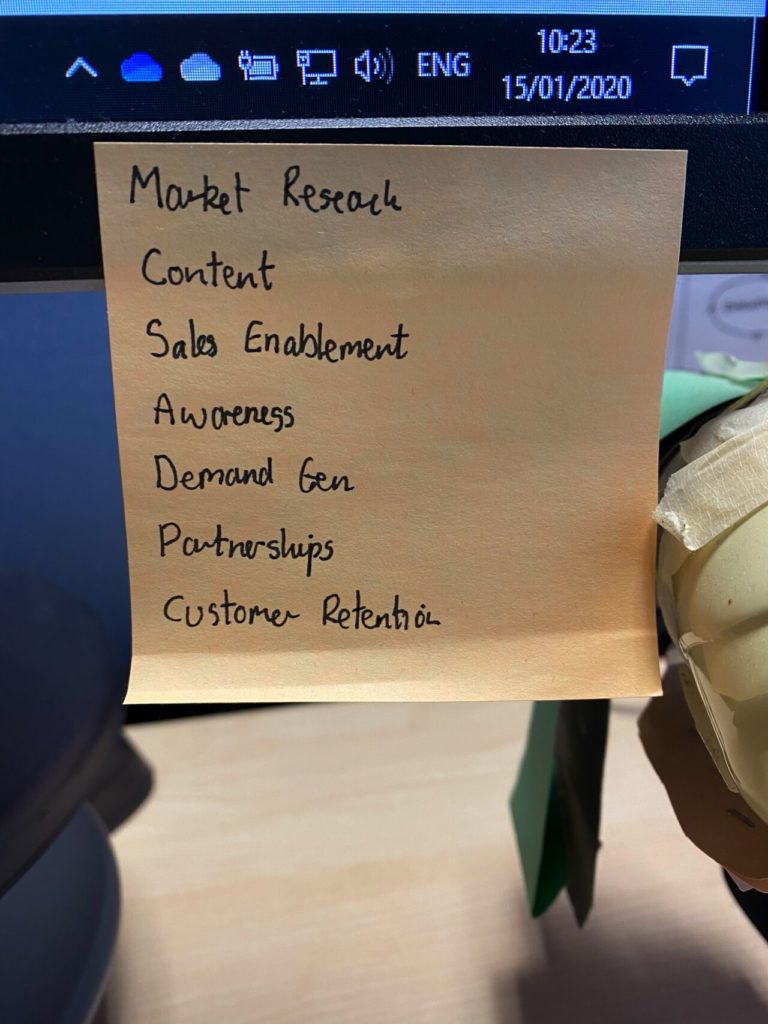What should be in the plan?
When I moved into the CMO role I realised a number of ways in which the position was different to what I had done previously. A lot of these differences are to do with being in a C-level role, but I’ll focus here on the CMO position and the new things you need to learn for that job.
When I first started in this role years ago, it was overwhelming. Suddenly I was responsible for the marketing done by an already successful organisation, and there were 1,000 things I needed to get my head into. Yesterday. I realised then that what I needed was a structure for how to think about this set of responsibilities. After years of trying different models I managed to boil it down to the post-it note above, which is still stuck to my monitor years later. In my view, if you are in a CMO role, you should have a plan for each of these seven things. It might be that your plan is “This isn’t important to us, we’re a different type of business so I’m just going to ignore it”. But that’s still a proactive plan. If somebody asks you “Why aren’t you doing Google ads?” then you should have a well thought through answer, not just “Oh I haven’t really looked at that yet!”.
1. Market research
The core work on which everything below is founded. Market research – who actually wants the thing you sell? Why? What are the problems they are trying to solve? How many potential customers are there? How can you reach them? Who are the competitors? How do they position themselves? How does the market view their positioning vs. yours? And so on and so on. Often a founder knows these things (else you wouldn’t have got to a point where you have a viable company!). But as you mature you need product managers, product marketers and others around the business to understand the market more than anybody else. That last point is important – if there is another company in the market who understands how the market works better than you, then there’s a solid chance that they will beat you. Octopus Deploy is a good example of this. There is literally no company in the world that understands the deployment market better than they do. I believe this is a key reason why they do so well – if you are a customer why would you buy from the second most knowledgeable organisation?
How do you do this in your organisation? Simple, not difficult. You (personally) need to go out there and talk to customers. Yes, surveys are good and there are other ways of getting quantitative data. But you need qualitative data to and that comes from talking to people. If you’re going to write copy for an ad, how can you do that if you haven’t personally spoken to somebody that you’re trying to sell to? It can be difficult finding these people but there are options. Put up a stand at an event. E-mail existing customers offering them £50 for a chat. Run online surveys. Find a friendly industry expert who can give you the lowdown. But as a senior marketer, you or one of your colleagues needs to be doing this task. Oh and buy the book Obviously Awesome by April Dunford!
2. Content
No one likes adverts. Digital ads do work as part of the marketing flywheel, you need great content. What is great content? Simple – it’s content that people actually want to read. 98% of the content out there is bland, copycat, written by people who don’t understand the market and can be generated by ChatGPT. Your content needs to be remarkable in both senses of the word.
This is difficult. Finding people in your industry who can produce great content should be one of your highest priorities, but it will take up a lot of your time. You only need one or two but it’s much better to have one great writer than three average ones. And in my experience, it’s better to have somebody who’s an expert in your field and not the greatest writer in the world rather than vice versa. Most customers don’t mind about your grammatical errors.
But the thing that is so great about having good content is that it’s investment that will last you for a long time. A well written article about your domain can work for you for years to come. And then you’ll start to get people sharing links, commenting on posts and reposting articles. “Marketing” from someone that doesn’t work for you is always far more powerful because it is genuine and authentic.
But again, what can I do other than just writing great content? Well you can place that content on 3rd party sites. You can sponsor articles. You can encourage others to write about you. You can reuse content – if you’ve written a great white paper, cut it up in 20 different ways and use all of your snippets – a short advert, a podcast, a written article, a presentation. if you can get both things right (the creation and the distribution of information), then you’re maximising your use of content marketing as an activity.
3. Sales enablement

There are lots of different parts to sales enablement, particularly if you have a complicated sale that needs support. I’ll just focus here on the part that marketing can play.
But whose job is it to do sales enablement? Sales or marketing? I’ll dodge that question by saying that “You need some group in your company that is worried about sales enablement”. That may sit in sales or it may sit in marketing, or even somewhere else. But you can’t leave this crucial role to salespeople themselves. Without a sales enablement function supporting sales team you’re sending troops into battle unarmed.
There is an exception – where you don’t really have Sales at all! If you’re an online retailer and customers never really talked you during the sales process then sales enablement is less relevant for you. But otherwise, this is a key part of the senior marketing role and it is your responsibility to make sure it happens.
So your job in marketing is to set up the opportunities for the sales team to smash home (and generally they are Opportunities in Salesforce that you want to get to Closed Won). Sometimes of course a salesperson will generate an opportunity themselves, nurture it through and close it. But you’re not doing your job if you’re not enabling them with support, collateral, training, insights, and thirty other things which make their life easier. You may not get the glory when the points are scored, but without that teamwork between sales and marketing, with sales enablement as the bridge, the opportunities won’t close regardless of how good the original lead was.
4. Awareness

As per the earlier image, if you don’t have a large number of people who already know about you then you need to start earlier in the marketing life cycle. Nobody ever went from “Never heard of you” to “Here’s £25,000” in a week. They went through a whole series the complex stages ending with the sale. And this starts with basic awareness. Have they even heard your name? Is there any association between your name and the value you offer? A large part of your job as a marketing person is building the brand awareness, so that when the customer is looking at solutions there’s already a name there that they can trust (at least in part).
Building awareness is expensive, and in almost all cases, impossible to track. Yes you can do brand surveys and ask customers “Where did you first hear about us?”. And this is something you should do, perhaps a little later on. But either way, if you’re starting from scratch then it’s a long road ahead. And yes, there’s no way to go from zero to hero without a very large pot of money/investment.
How do you do this? Depends enormously on the industry. Paid-for advertising is an obvious answer but there are others. If your budgets are low then some ingenuity and creativity is needed. You need a crystal clear value proposition (why should the customer care?), good designers, a “Keep it simple” approach, but hopefully this should be one of the easier things to get going. These are some of the things I’d be thinking about:

5. Demand Gen
This is a tough stage to summarise. Theoretically everything you’re doing above is generating demand. I.e. the demand comes from the accumulation of all the other activities you’re doing.
But, in a senior role, you must know how to measure this even if you don’t know exactly what causes the generation of demand. To measure the performance of demand Gen, I would strongly suggest using “Value of opportunities created” as your KPI. i.e. Take the dollar value of opportunities created in a given month from Salesforce and use this to measure demand Gen performance. There are a few alternatives, but here’s why I don’t think they work:
- Number of leads. Anyone can generate leads. You can fool Google it’s giving you lots of leads – but they won’t convert. The goal here is money and without knowing whether the leads are any good this is a meaningless metric.
- Total revenue. Of course, this is what we’re all ultimately interested in. But there are so many contributions to this final figure (every department contributes to revenue), that it’s really difficult to pull apart where marketing has had an influence.
- Awareness or some other early stage metric. You should know what these numbers are, but they’re just too far away from revenue. And it can undermine your credibility with the leadership team if you’re reporting on “Page visits” in your marketing performance meetings.
So you must show the top level opportunity value generation numbers. But can you show further detail? I’d suggest the following as a starting point:
- Split the figures out by region
- Split the figures out by sales team (if different to above)
- Show the numbers for revenue from existing customers vs. new customers
- Show the numbers by different industries or segments
And a final tip – start simple then build up. Start with the super-reliable opportunity value metric, then when you and the rest of the leadership team believe that number, move on to the next one. If you don’t do this then you’ll spend management meetings explaining 20 charts but without actually saying anything useful for the rest of the team.
6. Partnerships
Crucial for reaching customers you simply can’t reach on your own. This could be for a number of reasons, but often it’s a matter of size. If you’re a company of, say, 100 people and you’re trying to sell to Lloyds Bank then it’s very unlikely they’ll even look at you. So your job is to try and find a bigger organisation willing to partner with you. NB: there are also obviously times when you can partner with smaller companies, but that’s not the big win here. Of course the mountain to climb here is convincing then to work with you at all. The prize is worth it, but it can be a long slog (often years). And generally, “Go big or go home” – a single partnership with Apple will provide more value 10 partnerships with smaller firms.
The two main types of partnership where I’ve seen most success are:
- Technical partnerships. Someone else provides a bit of technology that you don’t have, something that might take you years to develop and you need to get to market quickly.
- Commercial partnerships. Access to customers that you can’t reach on your own. A simple example of this is a new country – if you’re trying to open up Spain as a market, for example, and you know nothing about Spain then you need a partner or you’re going to spend a lot of time and money going in the wrong direction.
Because building partnerships can take a long time and be quite arduous, it is often better to hire a separate “Partner manager” of some sort, not only to get their expertise but because otherwise it can be an enormous distraction from the core business.
7. Customer Retention
I thought I’d end on something slightly controversial. The business that you work for should have a deep understanding and strategy for how customers are retained. You should know why people stick with you.
What’s controversial is what you can actually do about it in a marketing department. I believe most customers stick with the vendor because the product is great. Once you’ve bought from someone do you ever see their marketing again? You were busy using the product and getting on with your own projects and activities. A lot of money is spent on customer success and customer retention teams, I’m just not sure that’s money well spent. The product retains people. What that means, is that if you as a company have a problem with retention I would invest budget in the product rather than marketing. That’s a difficult argument to make if you work in the marketing department (“What do you mean you can’t help!?”). But that’s the essence of good strategy – making difficult calls where resource is constrained.
So I won’t write more about marketing customer retention as I’m not sure it’s something you should spend a lot of time on. But as always, very happy to be proven wrong!
These are the seven categories that I’ve used to try and understand all of the work that is going on in the marketing departments that I’ve been fortunate enough to run. as I say, in a senior role you should know why you are or are not doing something in each of these categories, and what value this work adds.

Leave a Reply